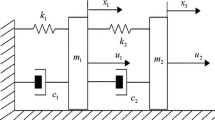Abstract
Evaluating the bounding set of dynamic systems subject to direct neural-adaptive control is a critical issue in applications where the control system must undergo a rigorous verification process in order to comply with certification standards. In this paper, the boundedness problem is addressed for a comprehensive class of uncertain dynamic systems. Several common but unnecessary approximations that are typically performed to simplify the Lyapunov analysis have been avoided in this effort. This leads to a more accurate and general formulation of the bounding set for the overall closed loop system. The conditions under which boundedness can be guaranteed are carefully analyzed; additionally, the interactions between the control design parameters, the ‘Strictly Positive Realness’ condition, and the shape and dimensions of the bounding set are discussed. Finally, an example is presented in which the bounding set is calculated for the neuro-adaptive control of an F/A-18 aircraft, along with a numerical study to evaluate the effect of several design parameters.










Similar content being viewed by others
References
Narendra KS, Annaswamy AM (1989) Stable adaptive control. Prentice Hall, New Jersey
Ioannou PA, Sun J (1996) Robust adaptive control. Prentice Hall, New Jersey
Hornik K, Stinchombe M, White H (1989) Multilayer feedforward networks are universal approximators. Neural Netw 2(5):359–366
Park J, Sandberg IW (1991) Universal approximation using radial-basis-function networks. Neural Comput 3(2):246–257
Narendra KS, Parthasarathy K (1990) Identification and control of dynamical systems using neural networks. IEEE Trans Neural Netw 7(1):4–27
Lewis FL, Yesildirek A, Liu K (1996) Multilayer neural-net robot controller with guaranteed tracking performance. IEEE Trans Neural Netw 7(2):1–12
Kim BS, Calise AJ (1997) Nonlinear flight control using neural networks. J Guid Control Dyn 20(1):26–33
Calise AJ, Hovakimyan N, Idan M (2001) Adaptive output feedback control of nonlinear systems using neural networks. Automatica 37(8):1201–1211
Hovakimyan N, Nardi F, Calise AJ (2002) A novel error observer-based adaptive output feedback approach for control of uncertain systems. IEEE Trans Automat Control 47(8):1310–1314
Campa G, Sharma M., Calise AJ, Innocenti M (2000) Neural network augmentation of linear controllers with application to underwater vehicles. American Control Conference, Chicago
Sharma M, Calise AJ (2001) Neural network augmentation of existing linear controllers. AIAA Guidance, Navigation, and Control Conference, Montreal, Canada, Aug 6–9
Chen W, Li J (2008) Decentralized output-feedback neural control for systems with unknown interconnections. IEEE Trans Syst Man Cyber Part B 38(1):258–266
Hayakawa T, Haddad WM, Hovakimyan N (2008) Neural network adaptive control for a class of nonlinear uncertain dynamical systems with asymptotic stability guarantees. IEEE Trans Neural Netw 9(1):80–89
Cao C, Hovakimyan N (2008) Design and analysis of a novel L1 adaptive control architecture with guaranteed transient performance. IEEE Trans Automatic Control 53(2):586–591
Institute of Electrical and Electronics Engineering, Inc (IEEE), Software Engineering Standards Committee (2004) IEEE standard for software verification and validation. IEEE 1012-2004, New York
RTCS and EUROCAE (1992) Software considerations in airborne systems and equipment certification. Radio Technical Commission for Aeronautics, Washington, DC
Farrell J, Sharma M, Polycarpou M (2005) Backstepping-based flight control with adaptive function approximation. J Guid Control Dyn 28(6):1089–1102
Kim N, Calise AJ (2007) Several extensions in methods for adaptive output feedback control. IEEE Trans Neural Netw 8(2):482–494
Maciejowski JM (1989) Multivariable feedback design. Addison-Wesley, Wokingham
Sontag E (1993) Neural networks for control. In: Trentelman HL, Willems JC (eds) Essays on control: perspectives in the theory and its applications (Groningen), vol 14, pp 339–380
Jordan C (1960) Calculus of finite differences. Chelsea Publication Company, New York
JB Pomet, Praly L (1992) Adaptive nonlinear regulation: estimation from the Lyapunov equation. IEEE Trans Autom Control 37(6)
Kosmatopoulos EB, Christodoulou MA (1997) High-order neural networks for the learning of robot contact surface shape. IEEE Trans Neural Network 13(3):451–455
Malini Lamego M (2001) Adaptive structures with algebraic loops. IEEE Trans Neural Network 128(1):33–42
Campa G, Mammarella M, Cukic B, Gu Y, Napolitano MR, Fuller E (2008) Calculation of bounding sets for neural network based adaptive control systems. AIAA Guidance Navigation and Control Conference, Honolulu
Wang C, Hill DJ (2006) Learning from neural control. IEEE Trans Neural Netw 17(1):130–146
Kurzhanskiy AA, Varaiya P Ellipsoidal toolbox 2006–2007. http://code.google.com/p/ellipsoids/
Eick RS (2003) A reconfiguration scheme for flight control adaptation to fixed-position actuator failures. MS Thesis, University Of Florida. http://purl.fcla.edu/fcla/etd/UFE0001265, Gainesville, FL 32611, 2003
Acknowledgments
Support for the 1st author was provided by the NASA IV&V Facility, Fairmont WV, trough the Office of Safety and Mission Assurance, Grant NCC5-685. The authors would also like to thank John J. Burken, for providing the inspiration to pursue this effort.
Author information
Authors and Affiliations
Corresponding author
Rights and permissions
About this article
Cite this article
Campa, G., Fravolini, M.L., Mammarella, M. et al. Bounding set calculation for neural network-based output feedback adaptive control systems. Neural Comput & Applic 20, 373–387 (2011). https://doi.org/10.1007/s00521-010-0404-6
Received:
Accepted:
Published:
Issue Date:
DOI: https://doi.org/10.1007/s00521-010-0404-6




